
In camping, a ground pad, sleeping pad, thermal pad, sleeping mat, or roll mat is lightweight pad, common among hikers, backpackers and budget travelers, often used in conjunction with a sleeping bag. Its purpose is to provide padding and thermal insulation. All types currently available use air as their primary form of insulation.

A dry suit or drysuit provides the wearer with environmental protection by way of thermal insulation and exclusion of water, and is worn by divers, boaters, water sports enthusiasts, and others who work or play in or near cold or contaminated water. A dry suit normally protects the whole body except the head, hands, and possibly the feet. In hazmat configurations, however, all of these are covered as well.
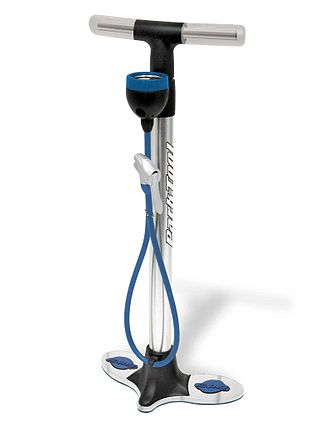
A bicycle pump is a type of positive-displacement air pump specifically designed for inflating bicycle tires. It has a connection or adapter for use with one or both of the two most common types of valves used on bicycles, Schrader or Presta. A third type of valve called the Dunlop valve exists, but tubes with these valves can be filled using a Presta pump.
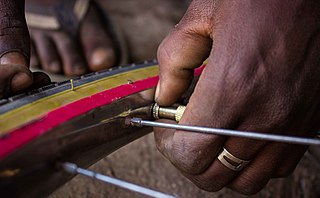
A valve stem is a self-contained valve which opens to admit gas to a chamber, and is then automatically closed and kept sealed by the pressure in the chamber, or a spring, or both, to prevent the gas from escaping. They are most commonly used on automobile, motorcycle, and bicycle tires, but also for many other applications.

An air mattress is an inflatable mattress or sleeping pad.

A diving regulator is a pressure regulator that controls the pressure of breathing gas for diving. The most commonly recognised application is to reduce pressurized breathing gas to ambient pressure and deliver it to the diver, but there are also other types of gas pressure regulator used for diving applications. The gas may be air or one of a variety of specially blended breathing gases. The gas may be supplied from a scuba cylinder carried by the diver or via a hose from a compressor or high-pressure storage cylinders at the surface in surface-supplied diving. A gas pressure regulator has one or more valves in series which reduce pressure from the source, and use the downstream pressure as feedback to control the delivered pressure, or the upstream pressure as feedback to prevent excessive flow rates, lowering the pressure at each stage.
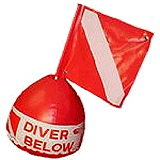
A surface marker buoy, SMB, dive float or simply a blob is a buoy used by scuba divers, at the end of a line from the diver, intended to indicate the diver's position to people at the surface while the diver is underwater. Two kinds are used; one (SMB) is towed for the whole dive, and indicates the position of the dive group throughout the dive, and the other, a delayed surface marker buoy, DSMB or decompression buoy, is deployed towards the end of the dive as a signal to the surface that the divers have started to ascend, and where they are going to surface. Both types can also function as a depth reference for controlling speed of ascent and accurately maintaining depth at decompression stops. Surface marker buoys are also used by freedivers in open water, to indicate the approximate position of the diver when submerged. They may also be used to support a catch bag or fish stringer by underwater hunters and collectors. A DSMB is considered by recreational scuba divers and service providers to be a highly important item of safety equipment, yet its use is not part of the entry level recreational diver training for all training agencies, and there are significant hazards associated with incompetent use.
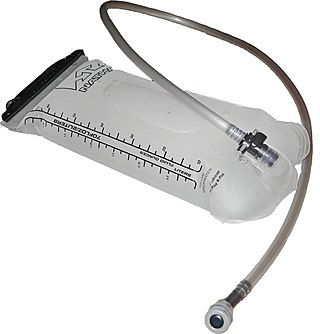
A hydration system is an apparatus used in recreation and other sustained outdoor activities. It is intended to help its user carry liquid, to support the physical effort involved in the activity, without the need to use one's hands or take off the pack. Such systems for consumers were first sold to cyclists, and by the 1990s had also found a substantial market among hikers. Familiar commercial models can also be recognized occasionally worn by western military personnel in southwest Asia.

A mattress is a large, usually rectangular pad for supporting a lying person. It is designed to be used as a bed, or on a bed frame as part of a bed. Mattresses may consist of a quilted or similarly fastened case, usually of heavy cloth, containing materials such as hair, straw, cotton, foam rubber, or a framework of metal springs. Mattresses may also be filled with air or water.
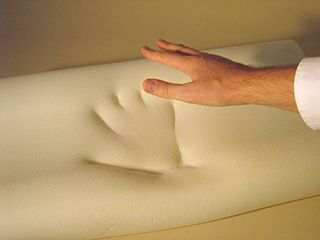
Memory foam consists mainly of polyurethane with additional chemicals that increase its viscosity and density. It is often referred to as "viscoelastic" polyurethane foam, or low-resilience polyurethane foam (LRPu). The foam bubbles or ‘cells’ are open, effectively creating a matrix through which air can move. Higher-density memory foam softens in reaction to body heat, allowing it to mold to a warm body in a few minutes. Newer foams may recover their original shape more quickly.
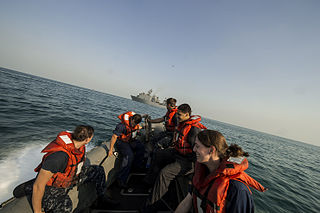
A personal flotation device is a flotation device in the form of a vest or suite that is worn by a user to prevent the wearer from drowning in a body of water. The device will keep the wearer afloat with their head and mouth above the surface – they do not have to swim or tread water in order to stay afloat and can even be unconscious.

A bag valve mask (BVM), sometimes known by the proprietary name Ambu bag or generically as a manual resuscitator or "self-inflating bag", is a hand-held device commonly used to provide positive pressure ventilation to patients who are not breathing or not breathing adequately. The device is a required part of resuscitation kits for trained professionals in out-of-hospital settings (such as ambulance crews) and is also frequently used in hospitals as part of standard equipment found on a crash cart, in emergency rooms or other critical care settings. Underscoring the frequency and prominence of BVM use in the United States, the American Heart Association (AHA) Guidelines for Cardiopulmonary Resuscitation and Emergency Cardiac Care recommend that "all healthcare providers should be familiar with the use of the bag-mask device." Manual resuscitators are also used within the hospital for temporary ventilation of patients dependent on mechanical ventilators when the mechanical ventilator needs to be examined for possible malfunction or when ventilator-dependent patients are transported within the hospital. Two principal types of manual resuscitators exist; one version is self-filling with air, although additional oxygen (O2) can be added but is not necessary for the device to function. The other principal type of manual resuscitator (flow-inflation) is heavily used in non-emergency applications in the operating room to ventilate patients during anesthesia induction and recovery.

An air pump is a pump for pushing air. Examples include a bicycle pump, pumps that are used to aerate an aquarium or a pond via an airstone; a gas compressor used to power a pneumatic tool, air horn or pipe organ; a bellows used to encourage a fire; a vacuum cleaner and a vacuum pump. All air pumps contain a part that moves which drives the flow of air. When the air gets moved, an area of low pressure gets created which fills up with more air.
In the context of an internal combustion engine, the term stroke has the following related meanings:

A sofa bed or sofa-bed is a multifunctional furniture typically consisting of a sofa or couch that, underneath its seating cushions, hides a metal frame and thin mattress that can be unfolded or opened up to make a bed. A western-style futon differs from a sofa bed, although sofa beds using futon mattresses are common.
Cascade Designs is an American company specializing in outdoor recreation products. It is located in Seattle, Washington and Reno, Nevada, and was founded in 1972 by two former Boeing engineers, who were avid backpackers. Their first product innovation was the self-inflating camping mattress, marketed as Therm-a-Rest. In 2015, Cascade Designs moved 1/5 of its workforce to Reno to take advantage of lower wages.

A flat tire is a deflated pneumatic tyre, which can cause the rim of the wheel to ride on the tire tread or the ground potentially resulting in loss of control of the vehicle or irreparable damage to the tire. The most common cause of a flat tire is puncturing of the tire by a sharp object, such as a nail or pin, letting the air escape. Depending on the size of the puncture, the tire may deflate slowly or rapidly.
The Talalay process is a method of producing molded pieces of latex foam rubber. A liquid latex rubber base is introduced to a closed mold and is then vacuumed of air. The mold is then frozen to stabilize the cell structure. Carbon Dioxide gas is introduced and the mold is heated to cure the rubber. Leon, Joseph and Anselm Talalay developed the "Talalay" process at various commercial entities. B.F. Goodrich in Shelton, Connecticut, Dunlopillo in Pannal, Harrogate, UK, and Vita Talalay in Maastricht, Netherlands, made this process commercially practical in the late 1940s. The first Talalay production plants were built in England, Canada and the United States.
The Outdoor Writers and Photographers Guild was established in 1980 as the Outdoor Writers Guild - a professional group for writers specialising in the outdoors. In 2006 the Guild changed its name to Outdoor Writers and Photographers Guild to recognise that members had professional skills in other areas to writing, with an informal strapline ‘Words and Pictures from the Outdoors’. Today’s membership includes writers, journalists, photographers, illustrators, broadcasters, film-makers, artists, web designers, publishers and editors, but all with the common bond of a passionate interest in the outdoors.















